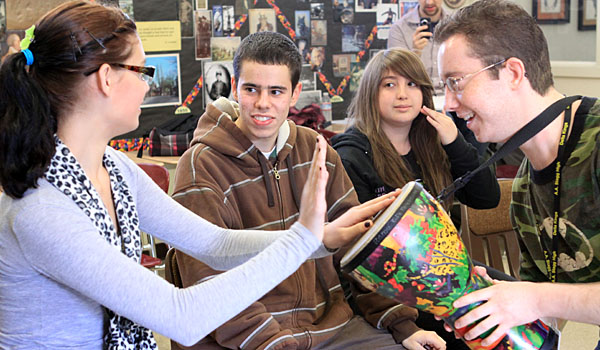Feel The Music

April 4, 2012
One intern begins to beat the drum. Another starts to play the keyboard. The students start to sing. The sound sends a wave of music through the P-wing. Walking into this classroom, you are surrounded by laughter and smiling faces. This is a normal Wednesday in P-1.
University of the Pacific interns come every Wednesday to direct a music therapy session. This class offers a release for special-education students who have issues at home or at school.
Observing this class from the beginning there would be no sign of students going through hardships. But as the class progresses they start to talk about their issues. With problems like being teased, breaking a remote control or even a father dying, this music therapy class offers ways for teens to cope.
Singing familiar songs and incorporating their own lyrics is part of the therapy session. Talking to a teacher, adult, family member or friend is one of the solutions that the interns suggest. Another form of individual therapy is writing or drawing.
“Playing makes me believe in myself, that I can play good,” sophomore Hillary Scott said.
Songs such as “Mirror” by Lil Wayne and Bruno Mars have meanings related to the lesson, which can offer therapy in a stylistic way. This song was broken down to observe and evaluate how the students live their lives.
But singing is not the only form of therapy during this session. The interns also incorporate dancing as well. One therapy session included dancing to multiple songs with scarves as a form of letting loose and releasing their stress. During this exercise, every student was participating fully in every activity. All students seemed as though this was something they wanted to do.
The interns try to make this experience as effective as possible. They do this by including every student in the class, either by asking for volunteers, greeting everyone, or adding in every student’s thoughts.
At the end of the therapy session, the interns ask for any suggestions from the students— what songs to add as well as what they liked and didn’t like about the therapy session.
Participating teachers say this session is effective for the students. “It improves people’s lives in an organized, systematic way, through music,” said Pam Curtin, a special day class teacher.
Along with the improvement of the lives of students, it also creates an exciting learning environment. As the music arises, the combination of singing and dancing makes students look forward to going to music therapy. “I get excited for music therapy. I don’t get to sing a lot,” junior Jordan Arndt said.
